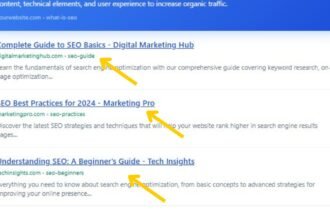If you’re publishing content online and still guessing which keywords to target, you’re basically showing up to a Formula 1 race on a bicycle.
Keyword research isn’t just step one in SEO—it is SEO.
Understanding how to find keyword for SEO is the difference between content that disappears into the digital abyss… and content that climbs to the top of Google like it owns the place.
Let’s get one thing straight: search engines don’t rank content because it’s poetic, beautiful, or well-meaning. They rank it because it answers specific questions in the language people are actually using. And that starts with the right keywords—primary, LSI, and NLP-driven.
“93% of online experiences begin with a search engine — and 75% of users never scroll past the first page.” — Growtha, 2025
In this publication, I’m walking you through the exact keyword research framework that’s helped scale organic traffic by 200%+ in under 6 months for startups, ecommerce brands, and B2B juggernauts alike.
Whether you’re trying to attract your ideal customer, boost visibility on a shoestring budget, or build content that truly resonates—learning how to find keyword for SEO is your unfair advantage.
What Is Keyword Research and Why It Matters in SEO

Keyword research is like eavesdropping on your ideal customer—ethically. It’s how you tap into the actual words, questions, and problems people are searching for online. When done right, it turns your content into a magnet for visibility, relevance, and clicks.
But here’s the kicker: knowing how to find keyword for SEO isn’t just about traffic—it’s about the right traffic.
You could rank #1 for “banana bread recipe” tomorrow, but if you sell B2B SaaS, you’ve just wasted effort, time, and server space. Strategic keyword research ensures your content speaks directly to user intent, whether they’re ready to buy, looking to compare, or just gathering information.
How Keyword Research Has Evolved (and Why It’s Not 2010 Anymore)
A decade ago, SEO was about stuffing exact-match keywords into every paragraph like your blog was a Thanksgiving turkey. Today? That’ll land you a one-way ticket to page 10 of Google, aka no man’s land.
Also Read: What Are The 4 Types of SEO?
Google’s algorithm now uses Natural Language Processing (NLP) and semantic understanding to rank content based on meaning and context, not just keyword repetition. That’s where LSI (Latent Semantic Indexing) and NLP keywords come in—they help your content appear more relevant, conversational, and human.
In fact, according to Google’s Search Quality Guidelines, the goal is now to “satisfy user intent using helpful, authoritative content that demonstrates expertise.” Translation? You need the right keywords woven into a compelling, high-quality narrative.
The 3 Keyword Types You Need To Know
Before we jump into the practical steps, here’s a quick snapshot of the three keyword types that make up a winning SEO strategy:
- Primary Keywords
Your main focus keyword. Think: “How to find keyword for SEO.” - LSI Keywords
These are closely related terms that add semantic depth. Examples: “content optimization,” “organic search ranking,” “SEO strategy.” - NLP Keywords
Real-world, conversational phrases and modifiers that reflect how people search. Think: “What are the best SEO tools?” or “How to increase website visibility.”
These work together to help your content rank higher and connect better.
Use NLP Keywords to Match Real User Intent
NLP keywords are how people actually talk. These are the modifiers, questions, and phrase structures that make your content sound like a helpful friend, not an SEO robot.
How to source them:
- AnswerThePublic: See visual maps of what users are asking
- Google’s ‘People Also Ask’: Real-time data on question-based queries
- Analyze top-ranking pages and pull common phrasing from H2s and subheads
Example NLP keywords for our topic:
- “How do I do keyword research for SEO?”
- “Best free keyword research tool”
- “What’s the easiest way to find keywords?”
Tip: These keywords are especially powerful for ranking in Featured Snippets and voice search.
Measure Search Volume, Difficulty & Competition
So you’ve got a juicy list of keywords—primary, LSI, and NLP. But before you start weaving them into your content, you need to gut-check them.
Because here’s the truth:
A keyword with 100,000 searches a month means nothing if your site has zero chance of ranking for it.
This step is where you separate wishful thinking from data-backed opportunity.
What To Measure
Search Volume (SV)
Tells you how many times people search that keyword per month.
- High-volume keywords (10K+): Great, but often too competitive.
- Mid-volume keywords (1K–5K): Usually the sweet spot.
- Low-volume keywords (<1K): Still valuable—especially for long-tail targeting and niche audiences.
NLP Insight: A long-tail phrase like “how to find keyword for SEO as a beginner” might only get 150 searches/month, but the intent is hyper-specific—and likely to convert.
Keyword Difficulty (KD)
This metric reflects how hard it is to rank on page one.
- 0–30: Low competition (go for it!)
- 31–70: Moderate competition (needs solid SEO foundation)
- 71+: High competition (bring backlinks, authority, and a prayer)
Tools like Ahrefs, SEMrush, and KWFinder break this down with clarity. They’ll even suggest SERP features and click potential.
Cost-Per-Click (CPC) (Optional, but helpful)
If a keyword has high CPC, it means advertisers are willing to spend money on it—which often signals high commercial intent. This matters for affiliate sites, ecommerce, and lead-gen content.
Real Example Breakdown
Let’s analyze the keyword: “How to find keyword for SEO”
| Metric | Value |
| Search Volume | ~2,900/month |
| Keyword Difficulty | 42 (Moderate) |
| CPC | $4.50 |
| SERP Features | Featured Snippet, PAA box |
What does this tell us?
This keyword is searchable, achievable, and monetizable. Perfect for mid-level domains or new content clusters trying to build authority.
Balancing Act: Volume vs. Intent
Don’t chase volume blindly. A keyword like “SEO” might have 110K+ searches/month—but it’s vague, competitive, and hard to rank for.
Meanwhile, a keyword like “SEO keyword research tool for real estate blogs” might only get 70 searches—but those 70 users are gold if you’re selling an SEO service for realtors.
Analyze What Your Competitors Are Ranking For
Want a shortcut to winning keywords? Simple: steal like an SEO artist.
When you’re learning how to find keyword for SEO, your competitors have already done half the homework. All you have to do is reverse-engineer their strategy, figure out where they’re crushing it—and where they’re sleeping on opportunities.
Why Competitor Research Is a Keyword Goldmine
Think about it: your competitors are likely targeting the same audience. So if they’re ranking on page one for “best free SEO audit tool”—you need to know:
- What keyword got them there?
- What’s the search volume and difficulty?
- Can you do it better?
How To Spy Like a Pro (Using Tools)
Here’s the workflow I use to dig into competitor keywords:
- Start with a Competitor URL
Plug it into:- SEMrush (Organic Research tab)
- Ahrefs (Site Explorer → Organic Keywords)
- KWFinder (Competitor Analysis mode)
- Sort by Traffic + Position
Look for keywords driving serious clicks—not just impressions. This reveals what content is doing the heavy lifting. - Find Keyword Gaps
These are keywords your competitors rank for that you don’t.- Tool: Ahrefs’ Content Gap feature
- Strategy: Look for medium-difficulty, mid-volume keywords that they rank on page 2–3 for—then outrank them with superior content.
- Review Their SERP Titles and Snippets
What’s their hook? Are they answering the query clearly? Can you 10x the value with updated stats, examples, visuals, or structure?
Real-World Example: A Tactical Breakdown
Let’s say your competitor is “SEOforStartups.com”
You enter their blog URL into Ahrefs → Organic Keywords → Boom.
You find:
- “how to rank on Google fast” → 6.2K volume, KD: 38
- “best keyword research tool for beginners” → 3.1K volume, KD: 42
- “SEO strategy for startups” → 1.7K volume, KD: 28
That third one is ripe. You could write a definitive guide on startup SEO strategy and dominate that SERP with long-tail and NLP phrases.
Tips for Content Domination
- Always one-up their content. If they wrote “7 Tips,” give 10 with real examples.
- Update your content quarterly with new stats—Google loves freshness.
- Integrate primary, LSI, and NLP keywords naturally—don’t let it read like a machine wrote it (because… hi, one kinda did).
Group, Organize & Prioritize Your Keyword List
You’ve mined the gold—now it’s time to mold it.
Because knowing how to find keyword for SEO is only half the game. The other half? Structuring your keyword strategy like a blueprint.
Scattered keywords = scattered content.
Organized keywords = content that ranks, converts, and compounds over time.
Group by Intent and Theme
Not all keywords are created equal. Some answer questions. Others sell. Some are long-tail gems. Others are just buzz.
To make sense of your keyword haul, group them into these buckets:
| Group | Example Keyword | Purpose |
| Primary Keyword | how to find keyword for SEO | Anchor of your content |
| Secondary Keywords | SEO keyword strategy, best SEO tools | Support the main keyword |
| LSI Keywords | content optimization, organic search traffic, backlink analysis | Add semantic richness |
| NLP Keywords | how do I do keyword research?, what are the best SEO tools for beginners? | Target natural language + voice search |
| Long-Tail Keywords | free keyword tool for small business SEO | High intent, low volume, easy wins |
Why this matters:
Google rewards topical authority. If your content reflects a clear understanding of related ideas and intent, you’re far more likely to rank.
Prioritize by SEO Value
Once grouped, it’s time to prioritize. Here’s the checklist I use:
Relevance to your audience
Is this keyword something your ideal customer actually types into Google?
Search volume & keyword difficulty balance
A keyword with 3K volume and 25 difficulty? Chef’s kiss.
One with 20K volume and 85 difficulty? Maybe save it for later.
Ranking opportunity
Check the top-ranking content for that keyword:
- Is it weak? Outdated? Thin?
- If so, that’s your chance to swoop in and dominate.
Content fit
Does the keyword naturally lend itself to a blog post, guide, video, or landing page? Let your content type match the search intent.
Map Keywords to Content Calendar
Once you’ve filtered and scored everything, assign each keyword to a content plan:
| Keyword | Content Type | Funnel Stage | Priority |
| how to find keyword for SEO | Blog / Pillar Page | Awareness | High |
| best SEO tools for beginners | Listicle / Affiliate Post | Consideration | Medium |
| keyword planner for ecommerce | Case Study / Tool Comparison | Purchase | High |
| long-tail SEO strategy | Educational Guide | Awareness | Low |
Use tools like:
- Notion
- Trello
- Google Sheets
- Airtable
Whatever keeps you consistent and strategic.
Grouping + prioritizing isn’t busywork—it’s SEO architecture.
You’re building a house. Every keyword is a brick. Stack it right, and Google will reward you.
How To Use Keywords Naturally in Your Content
So you’ve nailed how to find keyword for SEO. Great.
But here’s the twist: search engines don’t reward keyword overuse—they punish it.
What they want is content that feels helpful, natural, and human—with keywords baked in like seasoning, not dumped in like salt.
Let me show you exactly how to do it.
Where to Place Your Keywords (Without Overdoing It)
Think of your primary and supporting keywords like signposts for both Google and your reader. Strategic placement makes them work harder without being obvious.
Key placement zones:
- Title tag
Example: “How To Find Keyword For SEO: A Step-by-Step Guide” - Meta description
150–160 characters, catchy + keyword-loaded
Example: “Learn how to find keyword for SEO and boost your rankings using primary, LSI, and NLP keywords with this proven strategy.” - URL slug
Example: yourdomain.com/how-to-find-keyword-for-seo - Introduction paragraph
Get your keyword in early—but naturally. No stuffing. - Subheadings (H2/H3s)
Especially for long-tail and NLP keywords.
Example: “How do I choose the right keywords?” - Body content
Spread primary, LSI, and NLP terms evenly—aim for 1 keyword per ~100 words to hit that % sweet spot of your choice. - Image alt text + filenames
Yes, Google indexes these too.
Example: alt=”how to find keyword for SEO using Ahrefs” - Anchor text for internal linking
Example: “Check out our guide on content optimization for better SEO.”
Keyword Stuffing: The Silent Killer
Here’s what not to do:
“To find keyword for SEO, you need keyword research tools to find keyword for SEO because keyword for SEO is important to find.”
Google is smarter than that. And your readers deserve better.
Instead, weave keywords naturally into conversational sentences. Add context, use synonyms, and make it sound like a human wrote it over coffee.
Writing Tips for Natural Keyword Integration
- Use NLP phrases as questions
Example: “What’s the easiest way to find keywords?” → Great for voice search and Featured Snippets. - Build in LSI keywords via context
Example: Instead of repeating “keyword research,” say:
“…a content optimization plan that targets organic search intent and improves ranking signals.” - Read it out loud
If it sounds awkward, cut it or rephrase. Your goal is SEO and readability. - Less is more
If you nail your structure and include high-quality content, you don’t need to brute-force your keywords.
Remember, Google ranks pages, not keywords.
Real Example: Keyword Integration In Action
Before (stuffed):
“To find keyword for SEO, you should use a keyword research tool to find keyword for SEO that has low competition. This helps you find keyword for SEO that works.”
After (natural):
“If you want to rank, you need to know how to find keyword for SEO that has strong intent, decent volume, and low competition. A solid research tool like Ahrefs or SEMrush makes that process easier.”
See the difference? One pleases bots. The other wins hearts—and rankings.
Sprinkle in these LSI/NLP gems for SEO lift:
- “SEO writing best practices”
- “Optimizing content for search engines”
- “Natural keyword usage”
- “Keyword integration techniques”
- “SEO-friendly content structure”
My Favorite Keyword Research Tools (Tried, Tested, and Battle-Ready)
You can’t master how to find keyword for SEO without the right tools. And no, your gut isn’t one of them.
From identifying high-value primary keywords to digging up long-tail gold, here are the tools I actually use—and why they belong in your arsenal.
The Essential Keyword Research Toolstack
| Tool | What It’s Great For | Free Version? |
| Google Keyword Planner | Reliable search volume, CPC, and related terms | Yes |
| Ahrefs | Competitor research, keyword difficulty, SERP analysis | Limited |
| SEMrush | Keyword gap analysis, domain overview, topic clusters | Limited |
| Wordstream Free Tool | Instant keyword suggestions + volume | Yes |
| LSIGraph | Discovering LSI keywords for semantic optimization | Limited |
| AnswerThePublic | Real user queries and NLP-style questions | Limited |
| KWFinder (by Mangools) | Long-tail keywords, ranking difficulty, SERP preview | Limited |
| Ubersuggest | All-in-one for beginners—keyword ideas, traffic estimates | Limited |
| SurferSEO | NLP keyword integration and content structure scoring | Limited |
How I Use Each One (Real Talk)
Google Keyword Planner
Great for a baseline. I start here to get broad keyword ideas and gauge average monthly search volume + competition score.
Use it when: You’re starting from scratch or planning PPC campaigns.
Ahrefs & SEMrush
My go-to for deep dives. I use them for competitor keyword audits, seeing top-ranking pages, and analyzing keyword difficulty scores with real-time SERP features.
Use it when: You want to reverse-engineer what’s already working—or dominate a niche.
LSIGraph
Perfect for building out LSI keyword clusters. It helps me expand on topics without repeating the same phrase 12 times.
Use it when: You’re writing long-form content and need to boost contextual relevance.
AnswerThePublic
Brilliant for NLP-driven blog titles and FAQs. It shows you exactly how users phrase their questions.
Use it when: You want voice search-friendly content or to nail Featured Snippets.
KWFinder
I use this when I’m hunting for long-tail gems—keywords with clear intent, low difficulty, and decent traffic.
Use it when: You’re targeting underserved niches or building bottom-of-funnel content.
Bonus: How to Choose the Right Tool (Based on Where You Are)
| Your Situation | Best Tools to Start With |
| New Blogger or Freelancer | Wordstream, AnswerThePublic, KWFinder |
| In-House Marketer or Startup Team | Ahrefs, SEMrush, Google Keyword Planner |
| Agency SEO or Content Strategist | Ahrefs + SurferSEO combo for full-stack analysis |
| Solo Ecommerce/Local Biz Owner | Ubersuggest, KWFinder, LSI Graph |
Resources for Further Reading
If you’re serious about mastering how to find keyword for SEO, here are the guides, blogs, and tools I recommend bookmarking right now:
- How to Do Keyword Research for SEO – HubSpot
→ Clean, beginner-friendly overview with solid visuals. - How to Do Keyword Research – Mailchimp
→ Excellent if you’re content-first and email-focused. - LSI Keywords and How to Use Them – Infidigit
→ Breakdown of why semantic relevance matters in 2025. - NLP & SEO: A Comprehensive Guide – Nestify
→ If you’re serious about voice search and algorithmic comprehension. - KWFinder Tutorial – Mangools
→ A practical guide for uncovering long-tail gems. - Free Keyword Tool – WordStream
→ Great starter tool with intuitive UI.
Conclusion
Let’s keep it real:
Knowing how to find keyword for SEO isn’t just about plugging terms into a tool and praying for clicks. It’s about understanding search behavior, analyzing real opportunities, and crafting content that aligns with what your audience actually needs.
Here’s your step-by-step power recap:
- Start with your primary keyword
- Layer in LSI and NLP keywords for context and intent
- Evaluate volume, difficulty, and competition
- Spy on competitors for smart shortcuts
- Group and prioritize based on business relevance
- Integrate keywords naturally across your content
- Use the right tools like a pro
Remember: 93% of online experiences start with a search engine, and 75% of users never scroll past the first page.
Strategic keyword research isn’t optional—it’s your competitive edge. (Source: HubSpot, 2024)
Whether you’re running a blog, an ecommerce store, or a SaaS empire, learning how to find keyword for SEO is what separates random rankings from consistent traffic.
Now go apply this. Refine it. Build something that ranks—and sticks.
Frequently Asked Questions on How To Find Keyword For SEO
What is the best free tool to find keyword for SEO?
Google Keyword Planner and WordStream’s Free Keyword Tool are top-tier free options for beginner-friendly keyword insights.
How many keywords should I target per post?
Start with 1 primary keyword, 2–3 secondary, 3–5 LSI, and as many natural NLP queries as context allows—always prioritizing readability.
What are LSI keywords?
LSI (Latent Semantic Indexing) keywords are semantically related terms that add context to your main topic—helping Google better understand your content.
What’s the difference between NLP and LSI keywords?
NLP keywords reflect how humans naturally ask questions (great for voice search and Featured Snippets), while LSI keywords enhance thematic relevance.
How do I use keywords without keyword stuffing?
Spread keywords naturally in titles, headers, meta descriptions, and content body. Write like a human first, optimize second.












